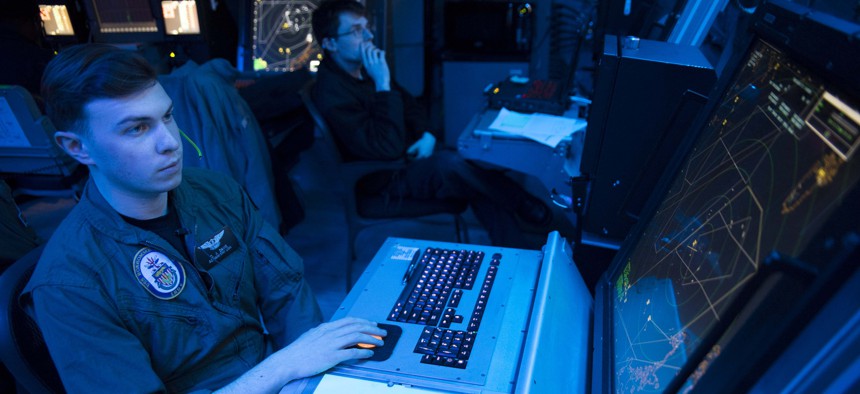
A U.S. sailor simulates an approach control watch in the amphibious air traffic control center aboard the amphibious assault ship USS Bonhomme Richard (LHD 6), somewhere in the U.S. 7th Fleet area of operations, March 20, 2016. U.S. Navy photo by Mass Communication Specialist 3rd Class Jeanette Mullinax
Five Possible Futures for the US Navy
Technology, especially networked algorithms, is changing the game. But which path will it take the Navy down?
The future of American naval power is in flux, perhaps more so than at any time since the simultaneous invention of submarines and aircraft about a century ago. An accelerating development of advanced technology resulting in the proliferation of ever “smarter” machines may soon alter operational doctrines across all physical domains. A critical mass of intelligent machines may create a type of warfare increasingly depopulated of humans and repopulated by unmanned systems. If cyberspace becomes a dominant domain of warfare, sea power may change even more radically.
The creation and sustainment of naval power can be framed as a four-factor problem-solving exercise. A simple memory device for the four factors, which was used with good effect in the education of several classes of midshipmen trainees, is the TIME model of naval warfare: naval power is generated at an ever-evolving nexus of Technology, Ideas (tactics, doctrine, strategy), Men and women, and Environment factors (in five domains). Expanded slightly: technology must be appropriate to the environment, guided by ideas whose creativity derives from men and women with imagination, integrity, and stamina.
But something new is afoot. With the rise of ever more intelligent machines, and the ability for fleets to act at increasing distances, the relationship between the human operator and technology is in a state of rapid change. Cumulative advances in artificial intelligence could produce a qualitatively new level of reliance on autonomous machines that challenges fundamental theories of war as a human and machine endeavor. The TIME model will still apply, but technology and pre-programmed ideas or machine learning may replace more and more operators on the battlefield, even though humans will still be the ultimate source of creative programming shoreside. Thus, the paths to the future of naval warfare are multiple. What are some possibilities?
Naval Warfare's Future
• With Maritime Superiority at Stake, US Navy Must Build Partnerships
• Five Possible Futures for the US Navy
• Naval Cooperation is More Crucial Than Ever. Here’s What It Costs.
• The Lessons of the Littoral Combat Ship
• To Confront Russia's Subs, NATO Must Team Up on ASW Aircraft
The maritime environments of the future may be so lethal that manned platforms simply cannot survive. In such a future, swarms of unmanned subsurface, surface, and air systems may be deployed to establish sea control to allow a permissive entry of traditional manned warships and aircraft.
Even more radically, war may accelerate to such speeds that only autonomous artificial general intelligence machines will be able to master its complexity, leaving human “commanders” and even “dumber” robots more as spectators than participants, perhaps only in “control” of an internet kill switch to avoid a cyber “checkmate.” But alternatively, should a cyber-battle be fought to a draw, where no side can gain an electronic advantage, decisiveness could shift back to more traditional naval capabilities, to the contender which preserved a modicum of analog systems controlled by more skilled human operators.
Another alternative future could see the installation of arms control measures that limit the technical advance of the American and rival navies. In the 1920s, it was the Washington Naval Treaties that restrained the growth of naval power for a decade. In the 1980s, it was the Strategic Arms Reductions Talks, which resulted in previously unimaginable cuts to nuclear arsenals. If such a future lies ahead, extant naval capabilities may continue to dominate calculations of sea power for decades to come.
Finally, an alternate future driven by global socio-economic disruption may await us. An economic shock could severely limit the ability of the United States to fund the building of a state-of-the-art navy. Is this unthinkable? It has happened before: in the aftermath of the American Civil War, a highly advanced navy was left to rust pierside; after World War II, the British economic decline shrank the Royal Navy to that of a regional power; in the wake of the Cold War, a similar fate beset the vaunted Soviet navy.
A last point: while the Navy is typically seen by outsiders as techno-centric, I believe that in the end, it won’t be technology that provides the most enduring trajectory to victory at sea. The cyber and robotic scenarios are unlikely to prove decisive for one simple reason: machines and computer code are not loyal to a single country; computer code can cross borders in seconds. In the face of the rapid diffusion of technology across the globe, the only long-term competitive advantage America can hope for ultimately resides in the American human factor: building and sustaining a Navy made up of American sailors of agile mind, strong bodies, and resilient spirit, and an education and training system that enhances these qualities. We are counting on Annapolis and the Naval War College, as well as the numerous NROTC units and the Naval Post Graduate School to be up to the task, and commit themselves to continually reinvent themselves, for the sake of our sailors and ultimate victory at sea.





